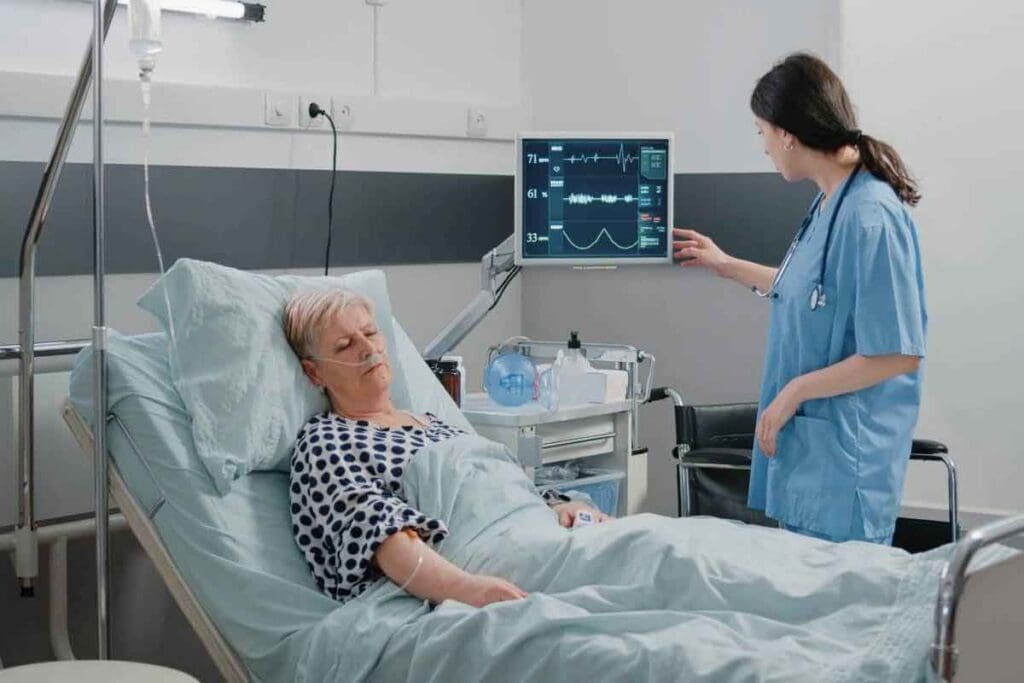Last Updated on November 20, 2025 by Ugurkan Demir

Sickle cell disease (SCD) is a genetic disorder that affects the production of hemoglobin. This leads to red blood cells that are shaped abnormally. It can cause serious problems, including acute chest syndrome (ACS), a dangerous lung issue.
ACS is a big worry for those with SCD. They need quick and special care. Knowing how ACS works is key to handling it well.

Sickle cell disease affects more than just hemoglobin. It also impacts lung function, making it a complex disorder. The disease’s complexity comes from its genetic roots and the effects on hemoglobin and overall body function.
Sickle cell anemia comes from a single mutation in the HBB gene. This gene codes for a part of hemoglobin. The mutation changes a glutamic acid to valine, creating abnormal hemoglobin, or HbS.
This abnormal hemoglobin makes red blood cells sickle-shaped when oxygen levels are low. This is because of the mutation in the HBB gene.
The abnormal hemoglobin in SCD causes red blood cells to become rigid and sickle-shaped. These cells are more likely to get stuck in small blood vessels. This leads to vaso-occlusive events.
Vaso-occlusion in the lungs is a big concern. It can cause tissue hypoxia, inflammation, and serious problems like acute chest syndrome (ACS).
The vaso-occlusive events are a key part of SCD. They greatly increase the disease’s impact. By understanding the genetic and pathophysiological aspects, healthcare providers can manage the disease better. This includes managing lung function issues.

Acute Chest Syndrome is a serious issue for those with Sickle Cell Disease. It shows up as a new spot on a chest X-ray, often with fever, breathing problems, or chest pain.
The signs of ACS can vary. But, it usually includes fever, cough, chest pain, and trouble breathing. These symptoms can be mild or very severe and can come on quickly.
Some people might also have hypoxemia, or low oxygen levels. This can make things worse. Other health issues can also affect how ACS presents.
It’s important to tell ACS apart from other lung problems. To diagnose ACS, there must be new lung spots on X-rays and symptoms like fever, chest pain, cough, or trouble breathing.
To confirm ACS, doctors do chest X-rays and lab tests. They check for infections, blood clots in the lungs, or other issues that might look like ACS.
Knowing how to spot ACS is key for doctors to give the right care to Sickle Cell Disease patients.
Acute Chest Syndrome is a serious problem linked to Sickle Cell Disease. It happens because of vaso-occlusion and inflammation. This condition shows up as new spots on chest X-rays, with fever, breathing issues, and chest pain.
The main cause of ACS is vaso-occlusion in lung vessels by sickled red blood cells. This blocks blood flow to the lungs, causing tissue damage. Sickling is triggered by low oxygen, acidosis, and inflammation, common in lung areas.
Tissue hypoxia from vaso-occlusion starts an inflammatory response. This response makes things worse. It involves many cellular and molecular pathways, releasing pro-inflammatory substances. This chain of events worsens ACS and leads to complications.
Without treatment, ACS can lead to lung infarction and respiratory failure. Lung infarction happens when blood flow to the lungs is blocked, causing tissue death. Respiratory failure may follow, needing mechanical ventilation and other support.
Today, ACS treatment mainly focuses on symptom relief and managing complications. But, finding treatments that directly address ACS’s pathophysiology is critical to better patient outcomes.
Acute Chest Syndrome (ACS) is the top reason for death in Sickle Cell Disease (SCD) patients. It’s a big reason for the sickness and death in SCD, causing up to 25 percent of deaths.
Vichinsky EP, et al. found that ACS is a big problem for SCD patients. Knowing the death rates and who is at risk helps doctors manage ACS better.
ACS has a high death rate, mainly in certain groups. For example, those who have had ACS before, have low hemoglobin, or have certain genes are at higher risk.
Knowing who is at risk helps doctors target treatments to lower ACS risk and death rates.
ACS’s high death rate comes from its severity, quick onset, and the difficulty in diagnosing and treating it.
Key factors contributing to high fatality rates include:
Understanding these factors helps doctors find ways to lower ACS’s death rate.
ACS is the second most common reason for hospital stays in SCD patients. This shows how big a problem ACS is for patients, healthcare, and the economy.
Hospital stays for ACS can differ a lot. This depends on the patient’s age, how severe their SCD is, and if they have other health issues. Both kids and adults with SCD can get hospitalized for ACS, with some ages facing worse episodes.
The time spent in the hospital for ACS can range from a few days to over a week. This depends on how bad the episode is and how well the treatment works. A clinic expert says quick and effective treatment is key to shortening hospital stays and better outcomes.
The cost of ACS hospitalizations is high. It includes hospital bills, treatments like blood transfusions, and medicines for pain and infections. Lost work time and the stress on caregivers also add to the cost.
ACS episodes also hurt patients’ quality of life. Frequent hospital visits can upset daily routines and lower well-being. It’s important to manage ACS well to improve patients’ lives.
“The management of ACS involves a multifaceted approach, including immediate initiation of antibiotics, supplemental oxygen, intravenous fluids, pain control, and often blood transfusion,” as noted by experts in the field.
Hospital care for ACS focuses on quick action and treatment. Patients usually get:
These steps are flexible to fit each patient’s needs. By sticking to these guidelines, doctors can help patients with ACS do better.
Diagnosing Acute Chest Syndrome involves spotting new lung issues and certain symptoms. This is a serious problem linked to Sickle Cell Disease. It needs a quick and correct diagnosis.
Imaging tests are key to diagnosing Acute Chest Syndrome. They show new pulmonary infiltrates on chest X-rays. These signs point to lung problems and are vital for diagnosis.
Along with imaging, certain clinical symptoms are important for diagnosing Acute Chest Syndrome. These symptoms are:
These symptoms can differ in how severe and what they combine. A detailed clinical check is needed.
Labs are essential in confirming the diagnosis and checking how severe Acute Chest Syndrome is. Key lab results include:
| Laboratory Test | Significance |
| Complete Blood Count (CBC) | Checks hemoglobin and white blood cell levels |
| Blood Gas Analysis | Looks at oxygen levels and breathing function |
| Lactate Dehydrogenase (LDH) | Shows tissue damage and hemolysis |
These criteria, as found by researchers like Ballas SK et al., are key for quick and right diagnosis of Acute Chest Syndrome. They help in managing the condition better and can lead to better results.
The causes of Acute Chest Syndrome (ACS) in Sickle Cell Disease (SCD) change with age. Kids and adults have different reasons for getting ACS. This affects how doctors diagnose and treat it.
Kids with SCD often get ACS from lung infections. Their young immune system makes them more prone to infections. These infections can lead to ACS. Vaccines and antibiotics help prevent these infections.
Adults with SCD usually get ACS from fat in the blood and not breathing well. Fat in the blood blocks blood vessels, causing pain and swelling. Not breathing enough, often due to pain or medicine, also plays a role. These reasons show why adults need different treatment than kids.
Treatment for ACS depends on the age of the patient. Kids need to fight off lung infections, while adults must deal with fat in the blood and breathing issues. Knowing these differences helps doctors create better treatment plans.
Understanding the causes of ACS in different ages helps doctors improve care. This targeted approach is key to better health for SCD patients.
ACS in patients with Sickle Cell Disease needs a special treatment plan. This plan includes quick actions, managing pain, and blood transfusions.
Quick actions are key in treating ACS. Oxygen therapy helps keep oxygen levels high, above 92% on room air. Giving intravenous fluids is also important to keep the body hydrated and to help sickled red blood cells flow better.
This helps prevent more problems and ensures tissues get enough oxygen. Guidelines by Liem RI et al. stress the importance of managing fluids carefully to avoid too much water in the lungs.
Managing pain is a big part of treating ACS. Adequate analgesia is needed to reduce stress and help breathing. Doctors use opioids carefully to control pain without harming breathing.
Blood transfusions are a key part of ACS treatment. They aim to lower the number of sickled red blood cells by adding normal ones. Simple transfusion boosts hemoglobin levels, while exchange transfusion replaces sickled cells with healthy ones.
| Treatment Aspect | Simple Transfusion | Exchange Transfusion |
| Purpose | Increase the hemoglobin level | Decrease % of sickled cells |
| Method | Transfuse blood | Replace the patient’s RBCs with donor RBCs |
| Indications | Mild to moderate ACS | Severe ACS, high risk of complications |
Choosing between simple and exchange transfusion depends on how severe the ACS is and the patient’s health. Guidelines say exchange transfusion is best for severe cases or when there’s a high risk of serious problems.
Antibiotics for Acute Chest Syndrome aim to cover a wide range of pathogens.
Guidelines suggest using broad-spectrum antibiotics for ACS. This is because of the high risk of infections, as noted by an expert.
When choosing antibiotics, consider common pathogens like Streptococcus pneumoniae, Haemophilus influenzae, and Mycoplasma pneumoniae. This ensures coverage for both typical and atypical bacteria.
Antibiotic choice should consider local resistance patterns and patient factors. This includes past infections and allergies.
A combination of a cephalosporin (like ceftriaxone) and a macrolide (like azithromycin) is often recommended. The treatment duration varies, usually between 7 to 10 days, based on the patient’s response.
| Antibiotic Class | Example | Coverage |
| Cephalosporins | Ceftriaxone | Broad-spectrum, including Gram-positive and Gram-negative bacteria |
| Macrolides | Azithromycin | Atypical bacteria, some Gram-positive bacteria |
For patients with recurrent ACS, managing antibiotic resistance is key. This involves monitoring resistance patterns and using antibiotic stewardship programs.
Antibiotic stewardship is vital to prevent resistance. It means using antibiotics wisely, reducing them when possible, and avoiding broad-spectrum coverage when not needed.
By using these strategies, healthcare providers can manage ACS effectively while reducing antibiotic resistance.
Stopping ACS from coming back is key for SCD patients. It takes a few important steps to do this.
Hydroxyurea is a big help in managing SCD. It makes more fetal hemoglobin, which lowers the chance of ACS. A clinical expert found that it cuts down ACS and other SCD problems a lot.
Hydroxyurea has many benefits:
For high-risk patients, chronic transfusions are very important. Regular blood transfusions add normal red blood cells to the body.
Chronic transfusion programs have a few key parts:
Vaccines and infection prevention are also very important. Keeping SCD patients up-to-date on vaccines like pneumococcal and flu is essential.
Understanding how acute chest syndrome (ACS) works is key to better care for sickle cell disease (SCD) patients. The National Heart, Lung, and Blood Institute has guidelines. These help manage SCD, including ACS.
To improve care for ACS in SCD, we need a few things. Early diagnosis and effective treatment are important. So is preventing ACS from happening in the first place.
Healthcare providers can make a big difference by knowing these facts. This can lead to better patient outcomes and fewer complications.
More research and better ways to manage ACS in SCD are needed. Working together, we can make life better for SCD patients.
Acute chest syndrome (ACS) is a serious problem in sickle cell disease (SCD). It shows up as new lung problems on scans. Symptoms include fever, chest pain, cough, and trouble breathing.
To diagnose ACS, doctors look for new lung issues on X-rays. They also check for fever, chest pain, cough, and breathing trouble. Lab tests can help confirm the diagnosis.
ACS happens when sickle cells block lung blood vessels. This leads to low oxygen, inflammation, and can cause lung damage and breathing failure.
In SCD, abnormal hemoglobin can cause red blood cells to sickle. This blocks blood flow in small vessels, including lung vessels, leading to vaso-occlusive events.
Treating ACS involves several steps. First, doctors use oxygen and fluids to help breathing. They also manage pain and may give blood transfusions.
Antibiotics are key in treating ACS. They help fight off lung infections caused by bacteria or other pathogens. Using broad-spectrum antibiotics is recommended.
ACS causes differ by age. In kids, it’s often due to lung infections. Adults are more likely to get it from fat embolism or not breathing well enough.
To prevent ACS from coming back, doctors use hydroxyurea, regular blood transfusions, and vaccines. They also focus on preventing infections.
ACS is a major reason for sickness and death in SCD. It’s the second biggest reason for hospital stays, causing a lot of suffering and cost.
ACS greatly affects the lives of SCD patients. It leads to many hospital stays and ongoing care. This makes living with SCD very challenging.
Subscribe to our e-newsletter to stay informed about the latest innovations in the world of health and exclusive offers!